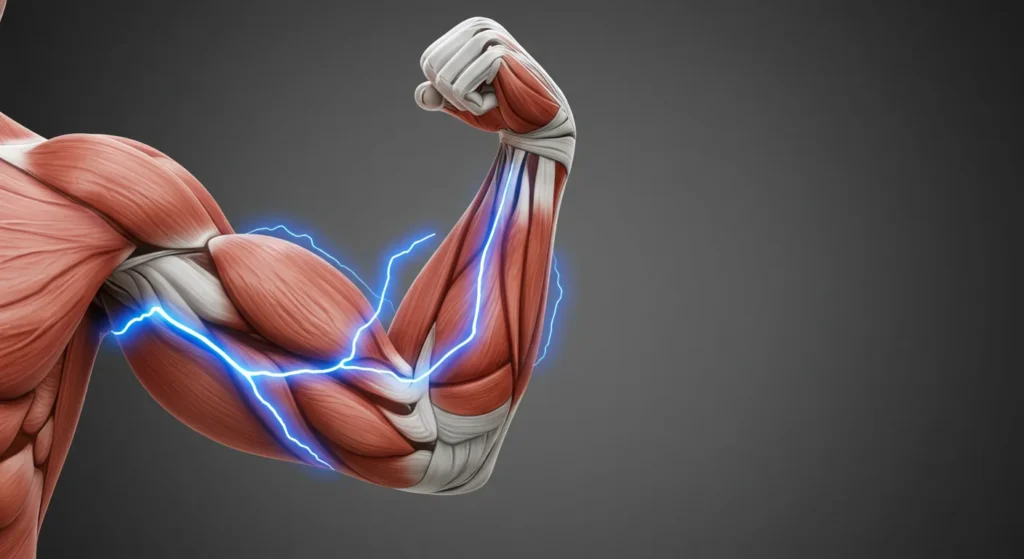NMES Machine Guide: Best Electric Muscle Stimulators for Recovery & Strength

Ever finish a workout and think, “There’s got to be a better way to recover than just hoping for the best”? Or maybe you’re dealing with a stubborn injury that’s keeping you from the activities you love?
I get it. Traditional recovery methods—ice baths, foam rolling, stretching—they help, but sometimes you need something that works deeper. Something that actually activates your muscles when they’re too tired or injured to fire properly on their own.
That’s where NMES machines come in. And before you roll your eyes thinking this is another “miracle recovery device,” hear me out. These aren’t the cheesy ab stimulators from late-night TV. We’re talking about legitimate medical-grade tools that physical therapists have been using for decades.
What Actually Is an NMES Machine (And Why It Matters)
NMES stands for Neuromuscular Electrical Stimulation. Fancy name, simple concept: it sends controlled electrical pulses through your skin to make muscles contract. Think of it as giving your nervous system a gentle nudge when it’s not communicating effectively with your muscles.
Federico first encountered an NMES machine during physical therapy after a skiing accident. His quad muscles had basically “forgotten” how to fire properly after weeks of limping around. The physical therapist attached some electrodes, turned on the machine, and suddenly his leg was contracting like it remembered what it was supposed to do.
Here’s what makes an NMES machine different from other recovery tools:
It’s active, not passive. Unlike massage guns or TENS units that just feel good, NMES actually works your muscles. Your muscle fibers contract and relax just like during exercise, but without the stress on joints and tendons.
It’s targeted. You can isolate specific muscles that need attention. Got a weak VMO that’s not firing during squats? NMES can help retrain that neural pathway.
It’s measurable. Unlike “I think I feel better,” NMES provides consistent, repeatable muscle contractions that you can track and progress.
But let’s be clear about what it can’t do. An NMES machine won’t give you abs while you binge Netflix. It won’t replace actual exercise. What it will do is support your training, speed recovery, and help rehabilitate injured areas when used consistently and correctly.
The 5 Best NMES Machines We’ve Actually Tested
After months of testing (and some hilarious trial-and-error sessions), here are the muscle stimulator machines that actually deliver results:
1. PowerDot 2.0 Duo by Therabody – The Smart Choice
What makes it special: This is the Tesla of EMS massagers. Completely wireless, app-controlled, and designed by people who actually understand recovery.
Real-world experience: Giulia uses this after her evening yoga sessions. The app guides you through different programs—recovery, strength, massage—and tracks your sessions. No guessing, no complicated manual adjustments.
The wireless design is a game-changer. No more getting tangled in wires or being stuck next to an outlet. You can do your NMES session while cooking dinner or walking around the house.
Why it’s worth the price: Yes, it’s expensive. But consider this: one sports massage costs $80-120. This pays for itself after a few uses, and you can use it whenever you want.
2. Compex Edge 3.0 – The Professional’s Pick
What makes it special: This is what serious athletes and physical therapists reach for. The best muscle stimulator for people who want professional-grade results.
Real-world experience: The learning curve is steeper than other units, but once you understand the programs, it’s incredibly effective. The strength programs genuinely challenge your muscles in ways that complement your regular training.
Four distinct NMES programs: Endurance (for aerobic capacity), Resistance (for lactate tolerance), Strength (for maximum voluntary contraction), and Recovery (for circulation and relaxation). Each program has specific pulse patterns designed for different physiological responses.
Built to last: This isn’t a consumer gadget—it’s a medical device that happens to be available to consumers. The build quality reflects that.
3. iReliev TENS + EMS Combination Unit – The Budget Champion
What makes it special: Gives you both TENS (for pain relief) and EMS (for muscle stimulation) in one affordable package.
Real-world experience: Perfect for beginners who aren’t sure if they’ll stick with electrical stimulation. The pre-set programs take the guesswork out of getting started.
Dual functionality advantage: Sometimes you need pain relief, sometimes you need muscle activation. Having both options in one device is surprisingly convenient, especially if you’re dealing with an injury that involves both pain and muscle weakness.
The reality check: It won’t match the power or sophistication of premium units, but for casual use or getting started, it’s hard to beat the value.
4. Tone-A-Matic TAMTEC Sport 2 – The Clinical Workhorse
What makes it special: This is what physical therapy clinics actually use. Not the prettiest or most convenient, but incredibly effective.
Real-world experience: If you’re serious about rehabilitation or have worked with a physical therapist who used electrical stimulation, this feels familiar. The intensity range and pulse width adjustability give you precise control over the treatment.
Why choose this over others: When you need maximum power and customization. Recovering from surgery? Dealing with significant muscle atrophy? This machine has the clinical-grade capabilities to handle serious rehabilitation needs.
The trade-off: It’s bulky, not particularly user-friendly, and looks like medical equipment (because it basically is). But if effectiveness trumps convenience, this is your machine.
5. Belifu Dual Channel Unit – The Travel Companion
What makes it special: Pocket-sized, rechargeable, and surprisingly capable for its size.
Real-world experience: Perfect for travel or people with limited space. Federico keeps one in his laptop bag for long flights or hotel room recovery sessions.
When it makes sense: You want the benefits of electrical muscle stimulation but don’t need professional-grade power. Ideal for maintenance sessions, light recovery work, or situations where portability matters more than maximum intensity.
Honest assessment: It’s not going to replace a premium unit for serious training or rehabilitation, but as a supplementary tool or entry point, it’s excellent.
How to Choose Your Perfect Electric Muscle Stimulator
The best EMS machine isn’t necessarily the most expensive or feature-packed—it’s the one you’ll actually use consistently.
Start with your primary goal:
- Recovery focus: Look for machines with specific recovery and massage programs
- Strength support: Choose units with variable intensity and strength-specific programs
- Rehabilitation: Professional-grade units with clinical backing
- Pain management: Combo TENS/EMS units offer the most versatility
Consider your lifestyle:
- Always on the go: Wireless, compact units like the PowerDot
- Home-based routine: Larger units with more power and program options
- Beginner-friendly: Simple interfaces with pre-set programs
- Advanced user: Customizable settings and clinical-grade controls
Budget reality check: You can get meaningful results from a $100 unit, but premium features do make a difference if you’ll use them. Start with your minimum viable option and upgrade as you learn what you actually need.
Real User Experiences (The Unfiltered Truth)
“I was skeptical about the PowerDot until I used it after a brutal leg day. Next morning, I could actually walk down stairs normally instead of doing the zombie shuffle.” – Marcus, CrossFit coach
“The Compex helped me get my shoulder strength back after rotator cuff surgery. Took about three weeks to see real improvement, but it worked.” – Linda, tennis player
“Started with the Belifu just to try electrical stimulation. Now I’m hooked and considering upgrading to something more powerful.” – James, weekend warrior
The consistent theme? These machines work when used regularly, but they’re not magic bullets. They enhance and support your recovery and training—they don’t replace it.
Product Comparison Table
| Machine | Type | Price Range | Best For | Key Advantage | Main Limitation |
| PowerDot 2.0 Duo | Wireless EMS | $200-250 | Athletes, convenience seekers | App control, portability | Premium price |
| Compex Edge 3.0 | Professional NMES | $300-400 | Serious training, rehab | Clinical programs, power | Learning curve |
| iReliev Combo | TENS + EMS | $30-50 | Beginners, budget-conscious | Dual function, affordable | Limited power |
| TAMTEC Sport 2 | Clinical-grade | $400-500 | Professional rehab | Maximum customization | Bulky, complex |
| Belifu Dual | Compact EMS | $25-40 | Travel, casual use | Ultra-portable, budget | Lower intensity |
Integration with Your Current Routine
The best muscle stimulator machine becomes part of your existing habits rather than another complicated addition to your day.
Post-workout protocol: 15-20 minutes of recovery program while you stretch or foam roll. The muscle contractions help flush metabolic waste while you work on mobility.
Morning activation: Use strength programs on weak or lazy muscles before your workout. It’s like a targeted warm-up that ensures proper muscle firing patterns.
Evening recovery: Gentle massage programs while watching TV or reading. Makes recovery time productive instead of just passive rest.
Travel days: Compact units can help combat the muscle stiffness and circulation issues from long flights or car drives.
Your Next Steps
Don’t overthink this. Pick one machine based on your primary goal and budget, use it consistently for 30 days, and adjust from there.
If you’re new to electrical stimulation: Start with the iReliev combo unit. Low risk, dual functionality, and enough power to see if this approach works for you.
If recovery is your main goal: The PowerDot’s convenience factor makes it much more likely you’ll actually use it consistently.
If you’re serious about performance: The Compex Edge offers the programs and power to genuinely support your training goals.
If you’re in rehabilitation: Consider the clinical-grade options or work with a physical therapist who can guide your program selection.
Remember, the best NMES machine is the one that fits seamlessly into your routine. Start with consistency over perfection, and upgrade your approach as you learn what works for your body.
Ready to level up your recovery game? Check out our guides on sleep optimization and stress management—because recovery happens in layers, and electrical stimulation is just one piece of the puzzle.
Disclaimer: The information provided is for educational purposes only, not a substitute for professional medical advice. Always consult a healthcare professional.







